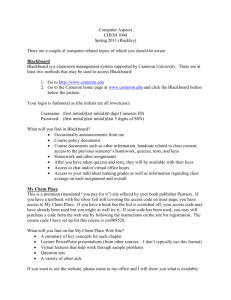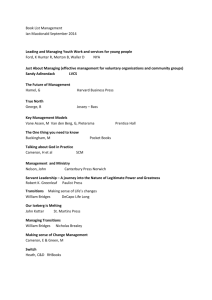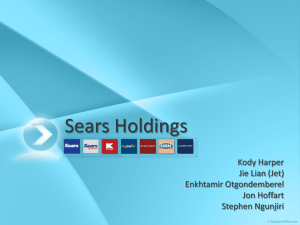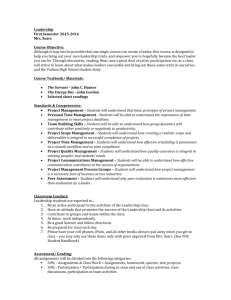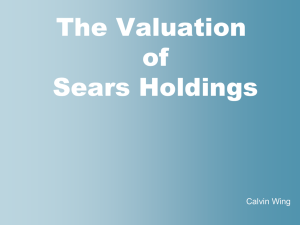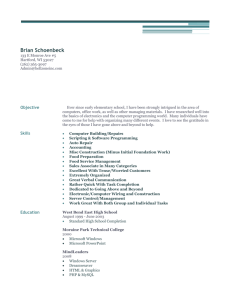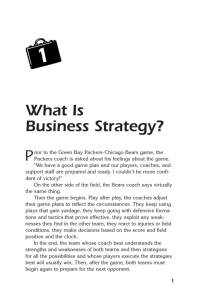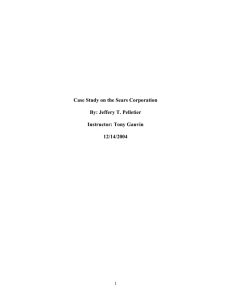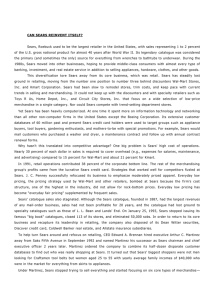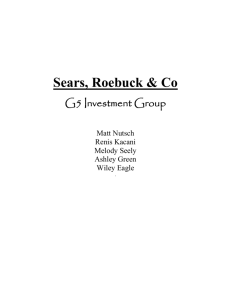Sears vs. Wal-Mart - Cameron University
advertisement
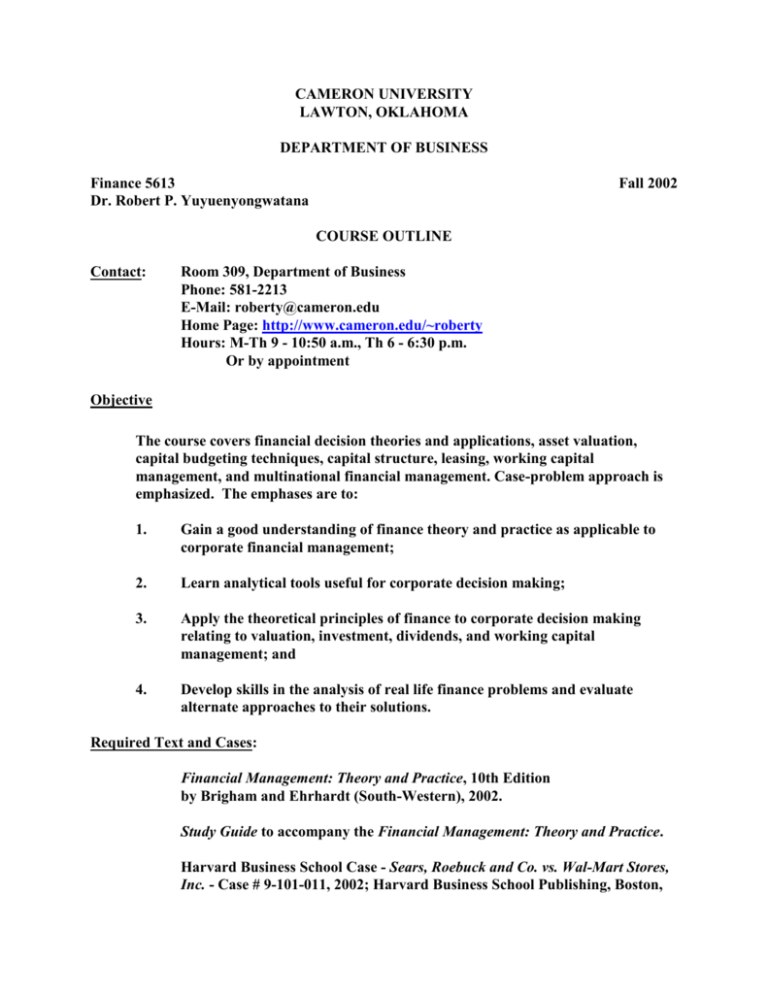
CAMERON UNIVERSITY LAWTON, OKLAHOMA DEPARTMENT OF BUSINESS Finance 5613 Dr. Robert P. Yuyuenyongwatana Fall 2002 COURSE OUTLINE Contact: Room 309, Department of Business Phone: 581-2213 E-Mail: roberty@cameron.edu Home Page: http://www.cameron.edu/~roberty Hours: M-Th 9 - 10:50 a.m., Th 6 - 6:30 p.m. Or by appointment Objective The course covers financial decision theories and applications, asset valuation, capital budgeting techniques, capital structure, leasing, working capital management, and multinational financial management. Case-problem approach is emphasized. The emphases are to: 1. Gain a good understanding of finance theory and practice as applicable to corporate financial management; 2. Learn analytical tools useful for corporate decision making; 3. Apply the theoretical principles of finance to corporate decision making relating to valuation, investment, dividends, and working capital management; and 4. Develop skills in the analysis of real life finance problems and evaluate alternate approaches to their solutions. Required Text and Cases: Financial Management: Theory and Practice, 10th Edition by Brigham and Ehrhardt (South-Western), 2002. Study Guide to accompany the Financial Management: Theory and Practice. Harvard Business School Case - Sears, Roebuck and Co. vs. Wal-Mart Stores, Inc. - Case # 9-101-011, 2002; Harvard Business School Publishing, Boston, MA 02163. Harvard Business School Case - Whirlpool Europe - Case # 9-202-017, 2001; Harvard Business School Publishing, Boston, MA 02163. A financial calculator. Texas Instrument=s BA II Plus is recommended. Recommended: The Wall Street Journal, Fortune, and BusinessWeek Prerequisite: Finance 3603 or Finance 5053 WITHOUT EXCEPTIONS! Grading: Midterm 100 points Final 100 points Case Report 100 points Class Participation and Case Discussion 100 points Total 400 points A: 360 - 400 points, B: 320 - 359 points, C: 280 - 319 points, D: 279 and below Class Policy: There will absolutely be no make-up exams. BE SURE you are adequately prepared for each class session. In addition to assigned readings of the chapters, you are expected to do work on a number of numerical problems, exercises from the text and the Study Guide, and other assigned problems, You should check the website for additional materials pertaining to the lectures (see Internet Access). Class attendance and participation are required and will be graded accordingly. Please be forewarned that any form of cheating will result in an immediate F for the course along with possible severe disciplinary actions taken by the College. The Cases: Two cases are included in the assignments. The cases provide practical learning experience and will help you to apply lessons learned during the course. Every student is expected to participate actively in the case discussions. A number of questions relating to each case is provided (see Questions Accompanying Cases). The questions help to highlight the main issues involved in each case. Your preparation for the case should include the appropriate financial analysis and computations. Each student is required to turn in a written report of any ONE of the two cases. The report includes a full analysis of the questions/issues involved and recommendations for the appropriate actions required to solve the problems faced by the company. All written report must be neatly typed and it should include all necessary spreadsheets and appendices. I will grade the case based on content and appearance. The report is due on the last day of class (Sunday, 11/24/2002). Internet Access You will be able to download certain information directly to your computer at home or work. I will provide you with the login id and password. Unless you access the webpage from several computer labs on campus, you need an internet service provider (ISP) to access the web page. My home page is: http://www.cameron.edu/~roberty . You may e-mail a case/assignment, as a text/binary attachment with your e-mail messages, to me. However, you MUST do them by the due dates. It is required that you have a working knowledge of e-mailing and browsing in the Internet. For more information, consult the following site: http://www.cameron.edu/admin/computer_services/index.html. In fact, you should log into the Cameron University web site: http://www.cameron.edu for complete information on the university policy, personnel, backgrounds, and computer accesses. Blackboard You are required to “enroll” this course via Blackboard. All new announcements, emails, digital drop boxes, and current grades/scores will be made through this system. This from of digital communication is especially useful for students living outside Lawton. Read “How to Create a Blackboard Account” below. How to Create a Blackboard Account Go to: http://blackboard.cameron.edu 2. Click on the "Create Account" button 3. Enter Personal Information --First Name --Middle Initial --Last Name --Email (it can be any email you want to use--make sure it is an account that is regularly checked) --Student ID (please use your assigned student’s number in case we need to identify you) 4. Enter Account Information --User Name (please use your first initial, middle initial, and complete last name) --Password (can be anything--make sure it is something that you will remember) 5. Other Information --Most of it is optional --It might be wise to leave a telephone number where you can be reached in case I need to contact you 6. Click on the “Submit” button 7. Confirmation—“OK “ 8. Enroll in Course --Under Course Catalog, choose Business --Scroll down until you find: Managerial Finance (FIN5613) --Instructor: Robert Yuyuenyongwatana --Out beside the title there will an “Enroll" button --Click the enroll button and that will allow you access to the course COURSE SCHEDULE * Date Chapter 11/8 1 - 3, 6, 8 Introduction, Review of Financial Statement Analysis, Probability Concepts, and Time Value of Money 11/9 6, 7 Risk and Return (may include Duration) 22 - 23 Working Capital Management and Financing 11/10 Topic Case: Sears vs. Wal-Mart Review for Midterm. 11/15 MIDTERM EXAM, ch. 1 - 3, 6 - 8, 22 - 23 11/16 Discussion of Midterm Exam 13, 14 Capital Budgeting - Review of the Basic Capital Budgeting - Advance Topics 20 Leasing 11/17 Case: Whirlpool Europe 11/22 16, 24 Capital Structure, Derivatives 11/23 24 Derivatives and Hedging (con=d) 27 11/24 27 International Finance International Finance (con=d) WRITTEN CASE DUE Review for Final Exam 12/6 * ******* FINAL EXAM ************* The schedule is subject to change with notice. Sears vs. Wal-Mart Questions Accompanying the Case Create a table and calculate the following ratios for the three years for both Sears and Wal-Mart: Current ratio, quick ratio, , total assets turnover, fixed assets turnover, inventory turnover (using cost of good sold), inventory turnover per day (days payable), days sales outstanding, days payable outstanding, debt ratio, time-interest-earned, fixed charges coverage, return on sales, net operating profit after taxes ratio, return on total assets, basic earning power, and return on equity. Where there are equity and total assets, use AVERAGE figures (for example, average the total assets for 1998 will be the 1997 and 1998 figures divided by 2). ADays@ mean per day based on 365-days year. 1. Compare the trends of these ratios for the two firms. 2. How do the retailing strategies of Sears and Wal-Mart differ? 3. Wal-Marts=s average return on equity for the 1997 fiscal year was 19.7% [$3,525/($18,503+17,143)/2] while Sears= average return on equity over roughly the same period was 22.0% [$1,188/($5,862+4,945)/2]. Don Edwards was puzzled by these numbers because of Wal-Mart=s reputation as a premier retailer and Sears= financial difficulties not long ago. What is driving the performance of these two companies during fiscal 1997? 4. What ratios are most important in assessing current and predicting future value creation for Sears? For Wal-Mart? 5. How useful are financial ratios in evaluating the current performance of each of the two companies? 6. How useful are financial ratios in comparing the relative performance of these two companies? Whirlpool Europe Questions Accompanying the Case 1. Are all of the benefits of the ERP investment reasonable? Are the costs reasonable? 2. What are the after-tax cash flows for the proposed ERP investment from 1999 through 2007? What is the present value of those cash flows? What is the net present value of ERP? 3. When valuing the proposed investment, should value be included for possible cash flows that occur beyond 2007? What does it depend on? 4. Would you recommend the ERP investment? What is your major concern?
